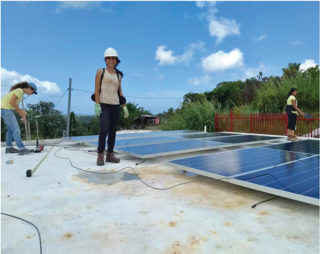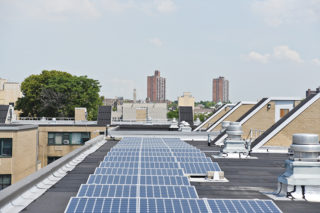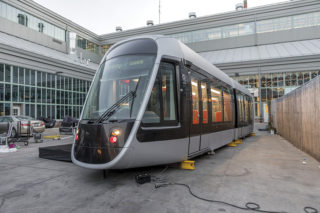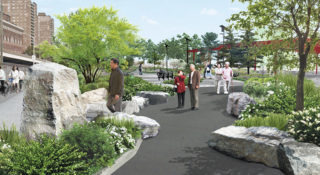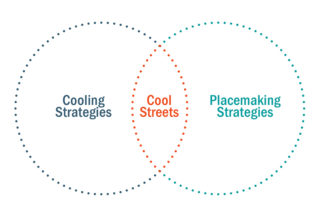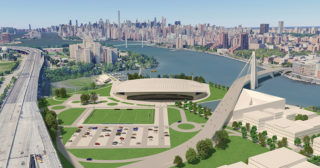As the theme for this issue of Oculus reveals, our community’s conversations are currently focused on social inequities related to climate, health, and opportunity. Indisputably, climate change, its causes, and its effects all disproportionately affect low-income groups and negatively impact their overall well-being. Approximately 20% of all NYC Housing Authority units are in flood zones, and 80% of the rental units in Superstorm Sandy’s surge area were publicly subsidized or stabilized. Carbon emissions and air pollution are concentrated in lower-income neighborhoods of color, resulting in high rates of asthma and other chronic health conditions, according to NYC’s Department of Health and Mental Hygiene. A 1997–2006 study published on the website ScienceDirect showed that high heat events in the city—exacerbated and made more frequent by climate change—also lead to higher mortality in these neighbor-hoods. Residential overcrowding, also much more common in low-income areas, has a direct correlation with infection rates of COVID-19, according to a report by the Citizens Housing Planning Council. And to top it all off, disadvantaged New York City residents, already facing housing insecurity, have less ability to move.
We need public policy to drive higher standards of sustainability and equity, but, as architects, we can also steer the way. If we make all buildings healthier, more efficient, and more affordable, we will help mitigate climate change and its disproportionate effects, particularly on disadvantaged populations’ health outcomes.
Affordable housing is already showing proven results. NYC’s Department of Housing Preservation and Development (HPD) has required Enterprise Green Community (EGC) as a sustainable criterion for a decade now. HPD-funded buildings are, at a minimum, 15% more energy efficient than code, and require low-VOC products and other materials that reduce indoor air pollution. The 2020 EGC certification incorporates WELL standards specifically focused on health. According to a report by Elyzabeth Gaumer of HPD, quality housing solutions such as these have a measurable positive impact on occupant health and overall comfort. They’re also reducing the city’s carbon footprint. Operational data from HPD’s first five Passive House buildings indicate that four of the five already meet Local Law 97 requirements for 2050, when the energy grid becomes carbon-free per state law.
To design healthier, high-performing buildings of all types, architects and engineers should look to proven examples like these and make low-carbon best practices common practices. C+GA regularly incorporates Passive House standards and recently completed the largest affordable multifamily Passive House in North America. Here are five basic Passive House strategies we believe can be applied to any project:
Insulate and seal the building while improving indoor air quality
Better building envelopes improve thermal performance and reduce energy use. In addition, tightly sealed, well-insulated structures can remain habitable for days without power, offering safer indoor options. Energy recovery ventilators filter out particulates and allergens, control moisture that can lead to mold and resulting respiratory issues, and provide fresh air.
Reduce on-site carbon consumption
A better envelope allows reduction in the size of mechanical systems and makes it easier to fully electrify them. In addition, we need to minimize electric loads from lights, appliances, and outlets. This can be done with off-the-shelf equipment and fixtures, reducing the cost barriers to low-carbon building.
Provide on-site power generation
Where practical, install solar photovoltaic panels and battery storage. This reduces stress on the power grid and provides partial 24/7 emergency backup power for medicinal refrigeration and charging of mobile phones and other devices—essential when it may take days or weeks for the lights to come back on after a storm.
Retrofit existing buildings
Renovations typically have a lower embodied carbon footprint than new construction. Deep energy retrofits can be difficult to achieve, as owners are often deterred by costs. Electrification of heating, cooling, and hot water currently has a significantly lower carbon footprint per BTU in operation, but fossil fuels are currently cheaper. We need to phase out fossil fuel usage through a combination of building codes, a carbon tax, and/or a ban. Electrification also goes a long way to improving air quality. And with the cost of renewable energy going down, on-site generation and all-electric provides an opportunity to substantially reduce operating costs for affordable housing, both public and private. This cost savings can then be passed on to residents and help increase affordable housing production, so everyone benefits.
Tout our successes
As New Yorkers, we are the USA’s carbon neutrality testing ground. A study published on CoolClimate Network found that NYC’s high density minimizes its per-capita carbon footprint. In addition, we’ve enacted critical policy initiatives. NYC’s Local Law 97 and NY State’s Climate Leadership and Community Protection Act in combination mandate an 85% carbon footprint reduction by 2050 and require a carbon-free grid by 2040. We can get there, but high-performing, all-electric Passive House projects—or their equivalent—must become the rule, not the exception.
We must make a personal and business commitment for change. While we lobby the federal government and wait for stronger sustainability mandates, we can still move ahead. The architectural community should commit to making our buildings more energy efficient and electrifying them. As design professionals, we must advocate for low-carbon and equitable projects with clients and collaborators. We need to push the low-carbon agenda forward and continue to develop exemplary projects that influence and inspire others.












